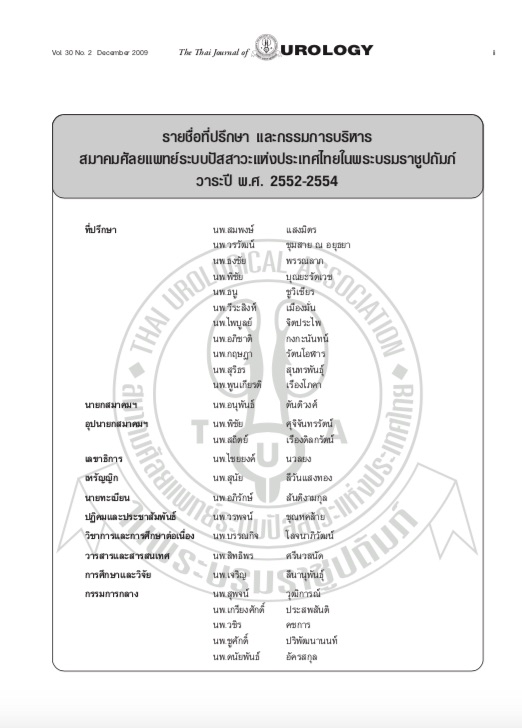Robotic Assisted Laparoscopic Radical Prostatectomy: When cure can come with quality of life
Keywords:
radical prostatectomy, prostate cancer, robotic prostatectomy, impotencyAbstract
Introduction: There are many options of treatment in early prostate cancer patients. Nowadays, the patients seek treatment aiming for cure without much troublesome. Robotic Assisted Laparoscopic Radical Prostatectomy is one of them.
Objective: To evaluate oncological and functional outcome of Robotic Assisted Laparoscopic Radical Prostatectomy performed by a single surgeonûs experience.
Materials and Methods: 155 patients with localized prostate cancer who underwent Robotic Assisted Laparoscopic Radical Prostatectomy were enrolled. Oncological and functional outcomes were evaluated.
Results: Within the last 48 cases, positive surgical margin rate was reported as 12.5% in pathological pT2 disease. One year after surgery, continence (pad free) rate and potency (successful sexual intercourse) rate were reported as 81.8% and 78 %, respectively.
Conclusion: Robotic Assisted Laparoscopic Radical Prostatectomy is one of the treatment options for early prostate cancer patients who aim for cure the lethal disease with good quality of life.
References
Srinualnad S. Extraperitoneal robotic assisted laparoscopic radical prostatectomy: The new approach for early prostate cancer. Thai J Urol 2007; 28(1): 1-6.
Srinualnad S. Early experience of robotic assisted laparoscopic radical prostatectomy. J Med Assoc Thai 2008;91(3):377-82.
Srinualnad S. Robotic Assisted Laparoscopic Radical Prostatectomy without Proctorship: Early Experience of the First Series in Asia. Thai J Surg 2008; 29(1): 1-5.
Srinualnad S. Sittipornûs Sound facilitating Urethro-vesical Anastomosis during Extraperitoneal Laparoscopic Radical Prostatec- tomy and Extraperitoneal Robotic Assisted Laparoscopic Radical Prostatectomy: The New Invention. Thai J Urol 2007; 28(2): 150-3.
Srinualnad S. Robotic Prostatectomy: Does the Approach matter? Thai J Urol 2008; 29(1): 39-42.
Srinualnad S. Outcome of Robotic Assisted Laparoscopic Radical Prostatectomy after 112 Consecutive cases. Thai J Urol 2009; 30(1): 1-5.
Cambio AJ, Evans CP. Minimising postoperative incontinence following radical prostatectomy: considerations and evidence. Eur Urol 2006; 50(5): 903-13.
Rocco B, Gregori A, Stener S, Santoro L, Bozzola A, Galli S, et al. Posterior reconstruction of the rhabdosphincter allows a rapid recovery of continence after transperitoneal videolaparoscopic radical prostatectomy.[see comment]. Eur Urol 2007; 51(4): 996-1003.
Menon M, Shrivastava A, Kaul S, Badani KK, Fumo M, Bhandari M, et al. Vattikuti Institute prostatectomy: contemporary technique and analysis of results. Eur Urol 2007; 51(3): 648-57.
Ahlering TE, Skarecky D, Borin J. Impact of cautery versus cautery-free preservation of neurovascular bundles on early return of potency. J Endourol 2006; 20(8): 586-9.
Kaul S, Savera A, Badani K, Fumo M, Bhandari A, Menon M. Functional outcomes and oncological efficacy of Vattikuti Institute prostatectomy with Veil of Aphrodite nerve-sparing: an analysis of 154 consecutive patients. BJU Int 2006; 97(3): 467-72.
Zorn KC, Gofrit ON, Orvieto MA, Mikhail AA, Zagaja GP, Shalhav AL. Robotic-assisted laparoscopic prostatectomy: functional and pathologic outcomes with interfascial nerve preservation. Eur Urol 2007; 51(3): 755-62.



